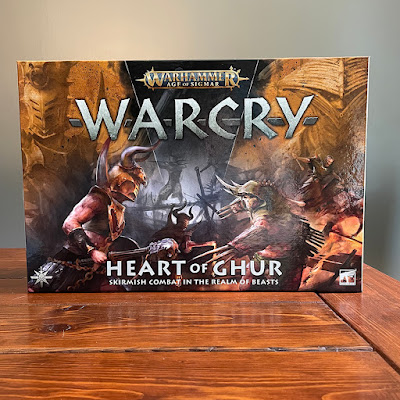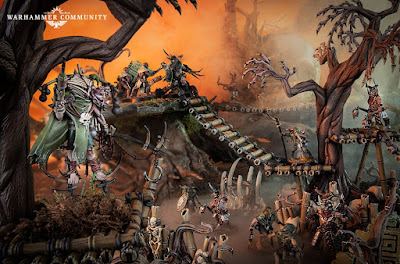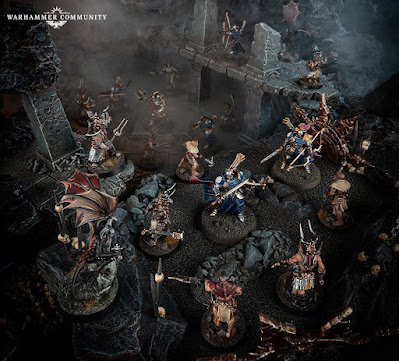First off, thank you to Games Workshop for having sent me an early review copy. As befits a Warcry starter set, this is a pretty hefty box. The first thing you'll notice is the design of everything is slightly different. That's because we've moved from the desolate wastes of the Bloodwind Spoil in the Eightpoints, to the sweltering jungles of the Gnarlwood in Ghur. As such, everything from the colors used to the fonts have changed. Gone are the chaotic elements, and in their place we have a lot more ambers, browns, and tans. Personally, I think I preferred the more chaotic look of the last edition, but I get the change, and it opens the game up to more factions as well as the idea of the setting changing again in the future. Come on Warcry Shyish!
Once you crack the box open you're greeted with a ton of sprues. In this edition you get two warbands, the Rotmire Creed and the Horns of Hashut. I'm definitely excited to see a Nurgle warband in Warcry. Alongside them you get a ton of scenery, this time in the form of several carnivorous Gnarloaks, bamboo platforms and bridges, and seraphon ruins. These trees and other scenery are much larger than I though they were from the pictures. Just look at the size of some of the bones!
The warbands are both pretty awesome sculpts. Naturally I was drawn to the Nurgle worshipping Rotmire Creed first. So far I've only had the chance to assemble and paint two of them. They're wonderful sculpts with tons of detail.
Besides the models you also get the traditional Warcry dice, but in Ghur colors, a ruler, all of the tokens you need, the core rulebook, the warband tome, and an instruction booklet for all of the models.
You also get all of the cards for picking scenarios, with a deck for deployment, scenery, twists and victory conditions.
As well as those cards, you also get all of the fighter and warband cards for the Rotmire Creed and Horns of Hashut.
Lastly, you get a new double sided game board to fight over. One side is more brown, while the other has a darker green tinge to it, as well as some Seraphon ruins. Personally, I think this one falls a little short of some of their other game boards they've released recently, both in older Warcry boxes, as well as the ones for AoS. It just lacks very much detail, but it's not horrible by any means.
The new rulebook is about the same thickness as the old one, but the most obvious change you'll notice right away is the aesthetic and setting. As previously mentioned, we're no longer in the Bloodwind Spoil, but instead in the Gnarlwood of Ghur! This is all part of the big Ghur thematic push within AoS at the moment, but instead of just being located in that realm in general, or even a bit more focused like in the continent of Thondia, we're instead in a very specific location, the Gnarlwood. The book wastes no time in establishing this new setting for you.
It opens up with several awesome looking double page spreads of artwork, before diving into the lore proper. The first four pages seem to be more for players who are entirely new to the setting of AoS as a whole. It quickly establishes what the Age of Sigmar is, and then moves into talking about the Era of the Beast, which kicked off with 3rd edition AoS. Once we have the basics established, we're able to zoom in a bit more to the Gnarlwood itself and why everyone is so interested in it. The Gnarlwood is a vast and untamed forest/jungle near the western coast of Thondia. Not only is it full of predatory beasts, but the forest itself is in fact predatory. Within the twisted branches lies the ruins of fabled Talaxis, the Ravening Ruins.
Comprised of numerous ziggurats and ancient ruins, Talaxis is actually the remains of a Seraphon voidship. Once known as the Eye of Chotec, it crashed down into Thondia in the distant past. With much of the ship obliterated and the rest in ruins, the powerful realmshaper engines at its heart (similar to the ones that Seraphon can take in their armies in AoS) sent out wave after wave of energy. This, overtime, transformed the surrounding area into what the Gnarlwood is today. Those Seraphon who survived the crash, reverted to their more primal ways with all of their Slaan dead. They now prowl the ruins and forest to protect their ancient ship. No one knows for sure what lies within, but legends talk about untold treasures and powerful artifacts locked away within the deepest vaults. This is what draws many of the warbands and adventurers towards it.
It then goes into more detail on the many dangers of the forest, but particular attention is paid to the Gnarloaks, the trees we're provided with models for in the boxed set. These carnivorous trees not only have claws at the ends of their branches, but they're able to literally stalk across the land to hunt for prey. This is followed by a map of the Gnarlwood with several key areas picked out as well as some faction symbols, presumably showing where they have fortified camps or strongholds.
Lastly in this section it goes over the ruins of the Eye of Chotec more with an awesome line drawing of the main part of the wreckage. It talks a bit about the interior of the ship/ruins and part of me hopes this setting up the follow up to Catacombs. I would love to get an expansion that deals with being inside of a dungeon again, but this time Seraphon themed!
Once we move on from the setting it goes into each Grand Alliance, covering each of the major factions that have rules in Warcry and giving a brief example and reason for why they would be fighting in the Gnarlwood. Each of these is two pages, followed by some painted examples of miniatures, except for Chaos, which gets four pages since it dives into the previous warbands a bit more in detail. This part also includes my favorite reason for why warbands are fighting within the forest. The smaller warbands of Chaos such as the Iron Golems and Spire Tyrants, basically any of the Warcry specific warbands for Chaos, made perfect sense to be duking it out within the Bloodwind Spoil, but how did they get all the way into Ghur? Once they heard about the riches hidden within Talaxis, many of these warbands enlisted with Archaon's armies and marched into Ghur with them. Once those armies reached the frontlines of the conflicts in Thondia, they mysteriously found that many of the smaller warbands had deserted, branching out on their own to find glory. They basically used Archaon's armies as a delivery system then ditched as soon as they got into Ghur. It's great. They also go into even more detail on the Untamed Beasts and Darkoath Savagers, as they're right at home within Ghur. Literally for the Untamed Beasts, as that's where they hail from.
This lore section takes up the first 55 pages of the book, and after that we move onto the rules. The core of the rules has more or less stayed the same, with a few major additions. I'm sure there have been minor tweaks here and there, or tightening up of some wording or mechanics, but to be honest, I'm not familiar enough with the old rules to notice those. I've played games of WarCry, but not in awhile. If you want an overview of the how the core rules work for a game, you can check out my review of the 1st edition of the game here. In this article I'm just going to touch on the changes I've noticed and the new additions.
So the very first thing I've noticed is actually with how the rules are presented to us. In the new rulebook there in a much more logical progression, and in my opinion, presented much more clearly. One super minor change is that the first phase of each round, the Hero Phase, is now called the Initiative Phase, which makes sense, since the main thing you do here is roll your initiative dice. The dice still work exactly the same, which is great since it's a fantastic mechanic and tons of fun.
Talking about the layout being more logical, the rules for how to construct your warband now come before the rules for moving, etc, which makes perfect sense! Your warband must have at least 3 fighters and cannot have more than 15 and all must be from the same faction with the exception of thralls, allies, and monsters. You are required to have at least one Hero who has to be your leader, but you can also have an additional 2 heroes for a total of 3, which I love. Since unit leaders, such as a Stormcast Prime, are Heroes in Warcry, it's nice to be able to include more than one. The points limit of your warband cannot be more than 1,000 points. Now, I'm going to skip ahead a little bit here to the Allies, Thralls and Monsters section, since it's all part of building your warband. You can now include up to 2 Allies, 3 Thralls, and 1 Monster in your warband. This seems to only apply for Open and Matched play, as Narrative play has a different way to add these into your warband, which I'll get to later. This is another great addition, as there are tons of cool warbands you can make with thralls and such.
As far as I can tell, there are no major changes to moving, fighting and activations, so I'm going to skip over those. In another example of some great re-organizing, the rules for Abilities has been moved to after all of those other rules. This is also so it can sit across from the major new addition to the game, Reactions. This seems to be a theme with GW games, starting with the Horus Heresy, so I won't be surprised to see it added into 40k and AoS in the future. Reactions are basically what they sound like, they're special actions you can do in response to something your opponent does. The core rules have 3 universal reactions, but the Rotmire Creed and Horns of Hashut each have a unique Reaction for their warband as well, Each Reaction tells you when you can do it and what to do. For example, Counter can come into play when a fighter is targeted in melee by an enemy fighter. You must declare you're using it before they roll any hits rolls, then any of your opponents hit rolls that miss cause 1 damage to themselves, with misses of a 1 causing 2 damage. There's also Take Cover, which gives you a chance to downgrade critical hits from missile attacks against you to a regular hit, and Strike Them Down gives you the chance to do D6 damage to an enemy fighter that disengages from you. The key thing with Reactions though, is they take one of your 2 Actions per fighter to do. So if you have already Activated a fighter and used both of their Actions, they won't be able to make a Reaction later that round. If you make a Reaction with a fighter who hasn't activated yet, then later when they do Activate they'll only have 1 Action. You can also make a Reaction with a fighter who used a Wait Action as their first Action.
The Core Rules finish out with some rules for how to interact with Objectives, Treasure, and other tokens, the Allies and Thralls rules I already went over, and then a catalog of all of the different Runemarks in the game.
After this we move onto the rules for the three ways to play, Open, Matched, and Narrative play, which takes up the rest of the book. Open Play has the rules for Coalition of Death and Triumph and Treachery, along with some special battleplans for those modes of play. Matched Play is pretty straight forward, with a small new addition. You can still use the card decks to construct your game as long as you stick to the cards that only have the Matched Play Runemark on them. Alternatively, the book provides you with 6 Matched Play battleplans, which give you the map, deployment, and victory conditions. The only card you need to draw is a terrain card, or you can use the rules for setting up terrain without a card. There's no twist card used. This is much more similar to how Matched Play works in AoS, which brings us to ones of the biggest changes in my opinion...
Narrative Play. This is very different from how Narrative Play worked in the 1st edition of Warcry. Gone are the campaigns of 12 battles with 3 convergences, special maps, locations, artifacts, and command traits tailored to each warband or faction. Instead we get something much more similar to how Path to Glory works in AoS. In fact, I would say it pretty much is Path to Glory, but with various Warcry appropriate things substituted in. You have an Encampment Location which gives you various bonuses and can be relocated throughout time. You earn glory which can be spent on upgrades, new fighters, or healing, etc. Instead of the campaigns with Convergences you have various quests you can embark on. Each quest will tell you what you earn once completed and how to complete them. After each game you gain glory, roll for injuries, earn Renown for individual fighters which lets them make free reactions, send fighters out to explore, heal fighters, add new fighters, and so on. It is very, very similar to Path to Glory, so if you've used that system in AoS then you'll be right at home here. I think this is a good change as the Path to Glory system works wonderfully. I am a bit sad to see the cool maps from the old campaigns go away, but that's about it.
The core book gives you 6 universal quests, including the ones that let you add allies, thralls, or monsters to your warband, as well as 3 unique quests for each Grand Alliance. Some of these quests have unique battleplans you have to play for the final battle as well, such as the Hunt the Beast quest for adding a monster to your warband. There are plenty of tables in the Narrative section as well for the various artifacts, abilities, and encampment locations. The section finished out with two Campaign Arcs, which tell you how many battles they are and often have unique battleplans and rules. Here we get The Path of Ven Talax, which is 3 battles, and uses a unique battleplan for each battle, and The Chotec Valley, which is 4 battles, but only has a unique battleplan for the final game. These are quite cool, and it mentions we can expect more in the future. In fact, we get two more in the Rot and Ruin book that comes in the box as well for the battles between the Rotmire Creed and Horns of Hashut.
Speaking of that book, the lore, rules, quests, and such for the two warbands that come in this box are broken out into their own book called the Rot and Ruin Warband Tome. This includes 21 pages of lore for the two warbands as well as plenty of painted examples.
The rules for each warband are presented here as well, although you also get these as the traditional warband cards we're used to. All of the rules for the unique terrain that comes in the box is presented here too. Mostly this is just telling you what counts as an obstacle and such, but the Watchtower and Rope Bridges both have special rules, such as being able to cut the Rope Bridges. Each warband gets 3 unique quests, including unique rewards and encampments, as well as the 2 campaign arcs I mentioned earlier. This book finishes off with the name and background generators we're used to from previous Warcry books. Honestly, I've used these quite a bit in the past when I've wanted to name specific characters from my AoS armies. The idea of Warband Tomes is quite exciting and I would love to see older warbands revisited like they've done with the Necromunda gangs. Add some more lore and a few new models.
I'm definitely excited to see Warcry move beyond the Eightpoints and out into the rest of the Realms. The new location opens it up to a lot more factions, as it's much easier to get into Ghur than it is to slip past Archaon's armies. The changes to the rules seem like a nice evolution too. Nothing too drastic, but enough to make the game feel more modern and smooth with more engagement from both players. It's interesting that the two starter warbands are still Chaos themed since that's no longer the main focus, but I feel like future ones will be more varied. Also, I'm not going to complain about getting some more Nurgle models. The new scenery feels suitably Ghurish and I think will mix well with the existing Warcry scenery. After a few more Warcry boxes we'll have a truly good mix of AoS scenery. If you're looking to jump into Warcry this is a great place to start and if you're a returning player and these warbands appeal to you then I'd say jump on into the Gnarlwood!
Until next time,
Tyler M.


























No comments:
Post a Comment